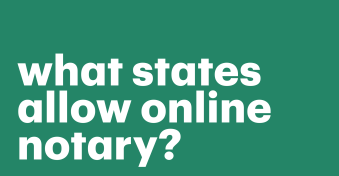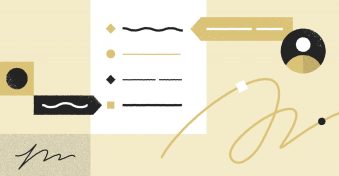Today, a notary signature has become vital for different types of notarized documents. Sooner or later, you will have to notarize a document, which is why knowing the answer to the question “what is a notary stamp” is important. Businesses and individuals opt for notary public services to fulfill their legal requirements.
Usually, court documents and banking transactions require mandatory notarization. The information revolving around notary stamps can be overwhelming. Remember that the notarization process, at its core, boils down to vetting, certifying, and record keeping.
In this blog post you’ll learn more about:
- What is a notary stamp?
- What is the purpose of notary stamps?
- What’s the difference between notary stamp, notary seal and digital notary stamp?
- Perks of a digital notary stamp
- Seven steps to create a notary stamp online
What is a notary stamp?
Notary stamps (also know as notary seals) are inked rubber stamps that are used to notarize a document and provide the notary public’s credentials for authentication.
Notary stamps can come in various colors, shapes, and sizes and are usually round or rectangular. Each state has its own requirements for what must be included in a notary stamp. These stamps typically contain the same information as a notary embossing seal.
A notary stamp contains crucial information unique to the notary public, including their name, state, commission expiration date, and commission number of the notary. And whether it’s a typical notary stamp, seal embosser, or digital notary stamp, the idea is to prevent fraud and ensure transparent notarization of transactions. It is important to understand that notarization can involve significant milestones in your life.
What is the purpose of notary stamps?
Notary stamps minimize or altogether prevent fraud in banking and legal documents. With notary stamps, you can attest and authenticate signatures. And without notary stamps, you wouldn’t be able to certify the authenticity of a legal document.
Whether it’s vehicle ownership, lien notice, handgun permit, death benefit policy, or life insurance policy, the use of a notary stamp is mandatory to assign beneficiaries and authenticate documents. It shouldn’t come as a surprise that all notarized documents need a proper notary stamp in the U.S.
Fundamentally, a notary stamp affirms that the contents of a document are correct and that the notarization has taken place in compliance with all local state notarization law.
What’s difference between notary stamp, notary seal embosser, and digital notary stamp?
Notary stamp
You can find notary stamps in various colors, shapes, and sizes. Notary stamps are typically designed in round and rectangle shapes worldwide. Some notary stamps also come with an ink pad that automatically releases the ink onto the stamp.
You may not be aware of it but you can also reink a notary stamp. From legal offices to banks, modern-day notary stamps are designed to last for a long time. You can also choose notary stamps that come in small sizes. For instance, if there is no room for a large notary stamp, you can use a small notary stamp that can fit into your pocket easily.According to the American Association of Notaries, you should opt for a dark color ink if you plan to get a notary stamp to make a notary stamp impression. It is the best way to ensure the ink stamp will clearly appear on the documents.
What is a notary seal embosser?
A notary embossing seal is a tool used to authenticate and notarize a signature by applying a unique embossed notary seal that contains the notary’s credentials and commission info. An embossing seal typically uses a metal crimping device that applies a round, permanent imprint to the document.
You can use a seal embosser to create a round or raised identification on any document with engraved information stamped on the seal embosser plate. Long before inked notary stamps became mainstream, notaries used to depend on seal embosser devices to take care of notarial acts.
With seal embossers, documents get an official and sleek look. In fact, the use of seal embosser devices is quite popular throughout the world. But despite the nature of a document, a notary seal embosser requires significant pressure to make a clear impression. On top of pressure, these devices need raised impressions through a separate inker.
When to use a notary seal?
You will need to obtain a notary seal or stamp for all documents that you wish to have signed and notarized by a commissioned notary public. While each state has its own requirements regarding what type of seal or stamp is necessary, as well as how it is applied, both a stamp and seal serve the same general purpose.
At the time of your document signing, the notary will apply their stamp or seal once the signers identities have been verified and the document has been signed within full compliance of state notary law.
What is a digital notary stamp?
Digital notary stamps are independent and virtually verifiable electronic images like a handwritten notary signature. You can retain digital notary stamps and attach them to any type of document in the blink of an eye. You can also link a digital notary stamp to specific data.
With digital notary stamps, it is easy to observe and review any changes in the document. You can look at a digital notary stamp through the lens of a virtual fingerprint scan on a virtual document. Unlike a traditional notary stamp, a digital stamp can be more unique to the document you want to notarize.
Contrary to naïve misconception, digitally notarized documents are legally binding just like inked notary stamps. In fact, digital notary stamps are more secure than conventional notary stamps. Digital notary stamps use algorithms to make sure the authenticity and validity of the information in the document is not compromised. Digitally notarized documents don’t have to deal with tempering.
When to Use Digital Notary Stamp?
Digital notary stamps are the same as traditional notary stamps, with the key difference that they are applied electronically to a document using a remote online notarization (RON) platform. Digital notary stamps, like traditional stamps and seals, are used to verify that a RON transaction has been completed in accordance with state requirements.
Once applied, they render a document legally enforceable.
Digital notary stamps provide the added benefit of increased security for your notarized documents. Digital stamps track keep a detailed record of any and all changes made to the document, preventing tampering and fraud. Digital stamps also utilize complex algorithms that work to ensure the authenticity of the document, the signer’s identities, and validity of information contained within the document.
Rather than requiring you to schedule a time and place to meet up with a notary to receive a stamp, Remote Online Notarization (RON) has made it easier to create, edit, eSign, and notarize documents, making it easy to apply a legally binding digital notary stamp.
Notary stamp or notary seal embosser: which one should you choose?
There is more than one type of notary stamp that often makes it difficult to make the right call. Objectively, when it comes to a notary stamp or traditional notary stamp embosser, it depends on the state you plan to notarize the document.
After all, each state has its own notary public laws on stamp devices. The right course of action would be to get familiar with “your” state’s stamp and notary embosser requirements. Oftentimes, the requirement may state that you need just an ink stamp or embosser.
But some states require you to have an ink stamp as well as an embosser. Whether it’s Florida or Arizona, look for dimensions, ink color, shape, and other required specifications of the notary stamp. Ideally, you should compare your notary stamp and notary seal embosser options as per state requirements.
In comparison, notary stamps are simple and easy to use. Not to mention, the notary stamp impressions pop up clearly on documents. Unlike notary stamps, seal embossers have a more official look to them and can be difficult to use. But a seal embosser makes more sense if you want to use it throughout the commission time.
5 benefits of digital notary stamp
One of the best aspects of digital notary stamps is that it allows you to deliver and maintain end-to-end workflows online. Besides, Remote Online Notarization (RON) has become easier than ever. The main perk of a digital notary stamp is that it offers a seamless and interactive digital experience to users.
You can integrate a digital notary stamp to notarize and initiate other online notarizations. At the same time, you can monitor the status of each digitally notarized document in real-time. In 2021, you can use a voice-enabled or digital video assistant device to track digitally notarized documents.
Whether it’s paper journals, travel logs, legal documents, or bank transactions, there is a good chance digital notary stamps will replace a good chunk of traditional notary stamps in the foreseeable future. The truth is that the idea of digital notarization of documents in a few minutes continues to gain more attraction. After all, digital notary stamps cut out the need for people to leave their offices or homes.
Digital notary stamps offer a flexible and interconnected process. For instance, digital notary apps now support integration that makes it easier to conduct online notarization of many files efficiently. You can even avail on-demand notary services that can verify notaries through dedicated notarization platforms. In fact, with each passing year, the digital notary space has become more competitive.
Despite the complex mechanics of a digital notary stamp, it opens up doors to a variety of use cases. On the other hand, digital notary stamps can get confusing when it comes to electronic notarizations. And that’s because a digital notary stamp is still not as widely accepted and used as paper-based notarization.
How to get a notary stamp online?
Now that you are familiar with use and purpose of traditional and digital notary stamps, you may be wondering how to get a notary stamp online? This step-by-step guide walks you through how easy and secure it is to get digital notary stamp using RON today.
1. Check eligibility
First, make sure you’re qualified as a notary public with commission identification. If you’re not eligible, you will have to wait a month or four weeks.
2. State approval
Second, you will need to get your state approval before moving forward. In short, make sure your state grants Remote Online Notarization (RON) status for documents.
3. Receive RON certificate
Your next move should be to receive a Remote Online Notarization or RON certificate. Some states ask the notary public to take an exam and then notarize documents through RON. The exam is simple and usually covers processes and the technology required to notarize an online document successfully.
4. Get a digital notary stamp
Like a physical notary stamp, you will need to create an electronic notary stamp to notarize documents. This is the main requirement to notarize documents digitally. You should also go through up-to-date and resourceful information on Remote Online Notarization. It will help you understand how to notarize documents online.
5. Buy a Federal Bridge certificate
You may have to get a Federal Bridge certificate for notarizing documents online. And that’s because some states mandate the notary to get a Federal Bridge digital certification. Through this certificate, governments can trust and verify digitally notarized documents.
In layman’s terms, a Federal Bridge certificate works like a digital identity. You can seek out a reliable and certified notary partner who can help you get the “right” certificate that meets your state’s requirements.
6. Choose a RON vendor
Despite the software or platform you choose, make sure to opt for one that allows Remote Online Notarization with modern technology. Also, make sure the vendor is compliant with your state’s mandated requirements.
Typically, make sure your vendor offers identity proofing, digital stamp compatibility, and digital notary journal. Oftentimes, the vendor may need to get approval from the State Secretary. The trick is to conduct basic research and research your options before choosing a vendor. Secured digital stamps are acceptable in most states.
7. Get ready to notarize online
Once you have an approved Remote Online Notarization status, you can start to notarize documents in the digital space. But follow official state guidelines without haste and make sure you’re compliant.
Ideally, you should opt for all-in-one digital notarization software. The RON platform you choose should be able to notarize documents in a secure fashion. Still, the process to purchase and use a dedicated RON platform may vary and come down to state laws.
Remember, not every state allows notaries to conduct Remote Online Notarization. For instance, Unlike Arkansas, California doesn’t allow notaries to perform remote online notarizations, whereas, South Carolina doesn’t even have digital notarization laws.
FAQ
How long can notary stamps last?
A notary stamp that has been applied to a notarized document will last for the duration of the terms laid out in the document. In other words, the authority of the seal does not expire until the document does.
Notary commissions in the United States are typically valid for up to four years. After the expiration period, the notary public will have to renew their commission and receive a new stamp with their updated information.
What is the process of getting a new notary stamp?
Each state has its own notary association where you can purchase stamps from a wide range of suppliers. But before you buy a notary seal with a specific shape, size, and color, you should check your state’s requirements.
For instance, the Florida notary stamp includes the notary’s name, commission expiration, and commission number in the text. You will also have to purchase black ink as per your state requirements.
Can you replace a notary stamp?
In short, yes. You can replace your notary stamp from your state’s notary association. In fact, you can replace a notary stamp at a fairly affordable fee in the U.S.
What happens when you lose your notary stamp?
Lost and stolen notary stamps get reported to the State Department. It is better to keep a record of lost, stolen, and replaced notary stamps to avoid discrepancies later on.
Where to stamp notary seal on document?
Within the boundaries of the notarial certificate, the notary public must affix his or her notary seal close to their notary signature.
Final thoughts
A notarized document with a stamp makes it easier to verify. As digital notary stamps become more mainstream and online fraud reaches an all-time high, it is crucial to notarize documents with stamps to avoid any type of fraud or identity theft. Without notary stamps, you may have to deal with endless court proceedings and even exploitation. Think of notary stamps as a proven measure that safeguards citizens’ rights.
















